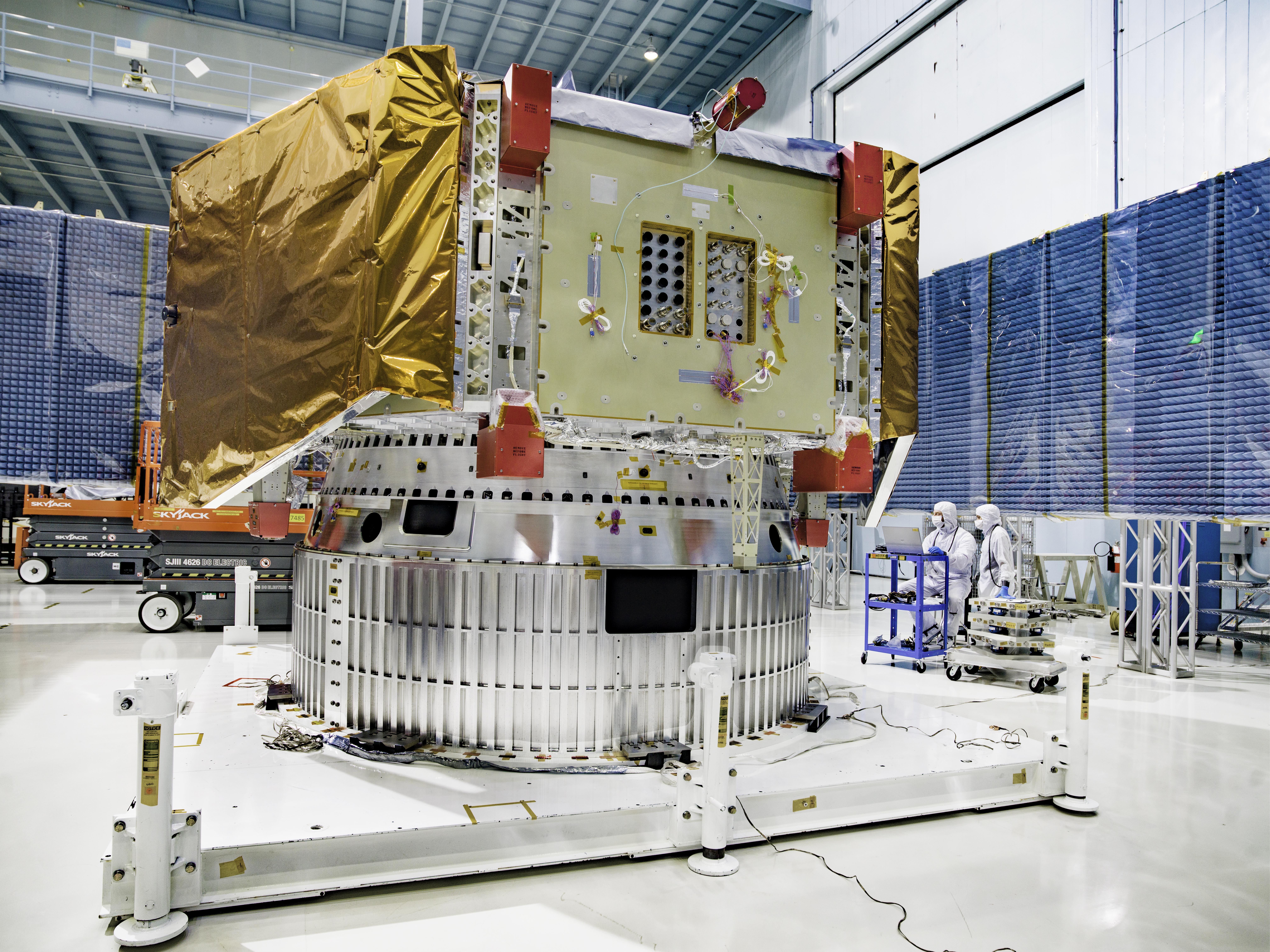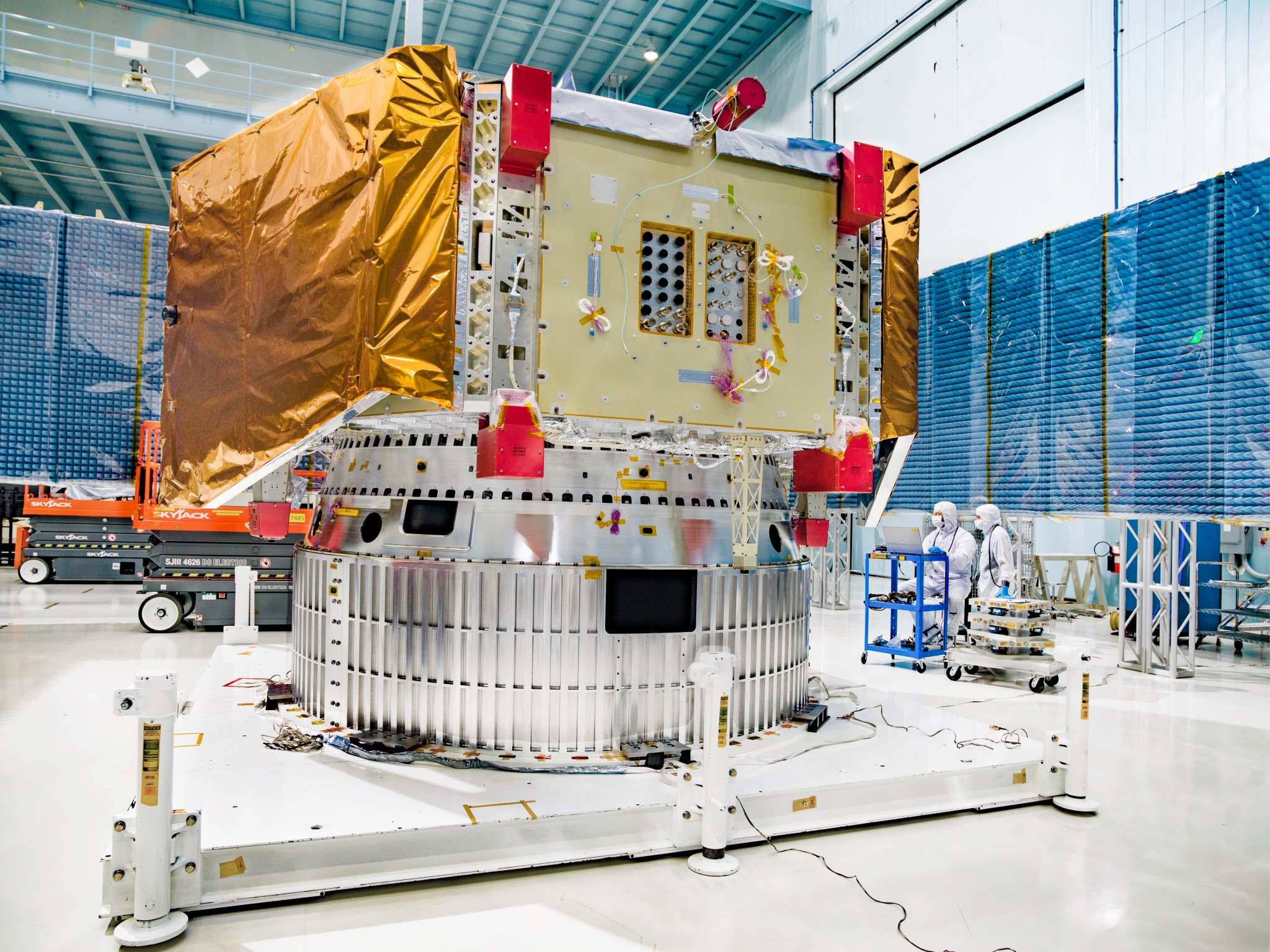 This enormous piece of space hardware is NASA’s Nancy Grace Roman Space Telescope’s spacecraft bus, which will maneuver the observatory to its place in space and enable it to function while there. It is photographed here in the largest clean room at NASA’s Goddard Space Flight Center, where engineers are inspecting it upon delivery. The bus rests atop an aluminum ring that will temporarily protect its underside. The two copper-colored flaps are Roman’s Lower Instrument Sun Shade –– deployable panels designed to help shield the observatory from sunlight.NASA/Chris Gunn The spacecraft bus that will deliver NASA’s Nancy Grace Roman Space Telescope to its orbit and enable it to function once there is now complete after years of construction, installation, and testing.
This enormous piece of space hardware is NASA’s Nancy Grace Roman Space Telescope’s spacecraft bus, which will maneuver the observatory to its place in space and enable it to function while there. It is photographed here in the largest clean room at NASA’s Goddard Space Flight Center, where engineers are inspecting it upon delivery. The bus rests atop an aluminum ring that will temporarily protect its underside. The two copper-colored flaps are Roman’s Lower Instrument Sun Shade –– deployable panels designed to help shield the observatory from sunlight.NASA/Chris Gunn The spacecraft bus that will deliver NASA’s Nancy Grace Roman Space Telescope to its orbit and enable it to function once there is now complete after years of construction, installation, and testing.
Now that the spacecraft is assembled, engineers will begin working to integrate the observatory’s other major components, including the science instruments and the telescope itself.
“They call it a spacecraft bus for a reason — it gets the telescope to where it needs to be in space,” said Jackie Townsend, the Roman deputy project manager at NASA’s Goddard Space Flight Center in Greenbelt, Maryland. “But it’s really more like an RV because it has a whole assortment of functions that enable Roman to accomplish its scientific goals while out there too.”
Those goals include surveying wide swaths of the universe to study things like: dark energy, a mysterious cosmic pressure thought to accelerate the universe’s expansion; dark matter, invisible matter seen only via its gravitational influence; and exoplanets, worlds beyond our solar system.
The mission’s science wouldn’t be possible without a spacecraft to transport the telescope, point the observatory toward different cosmic targets, provide power, communicate with Earth, control and store instrument data, and regulate Roman’s temperature. Nearly 50 miles of electrical cabling are laced throughout the assembly to enable different parts of the observatory to communicate with each other.
The spacecraft will also deploy several major elements that will be stowed for launch, including the solar panels, deployable aperture cover, lower instrument Sun shade, and high-gain antenna. It’s also responsible for collecting and beaming down data, which is no small task for a space observatory that will survey the cosmos like Roman will.
“Roman will send back 1.4 terabytes of data per day, compared to about 50 to 60 gigabytes from the James Webb Space Telescope and three gigabytes from the Hubble Space Telescope,” said Jason Hylan, the Roman observatory manager at NASA Goddard. “Webb’s daily downlink is roughly comparable to 13 hours of YouTube video at the highest quality while Roman’s would amount to about 2 weeks.”
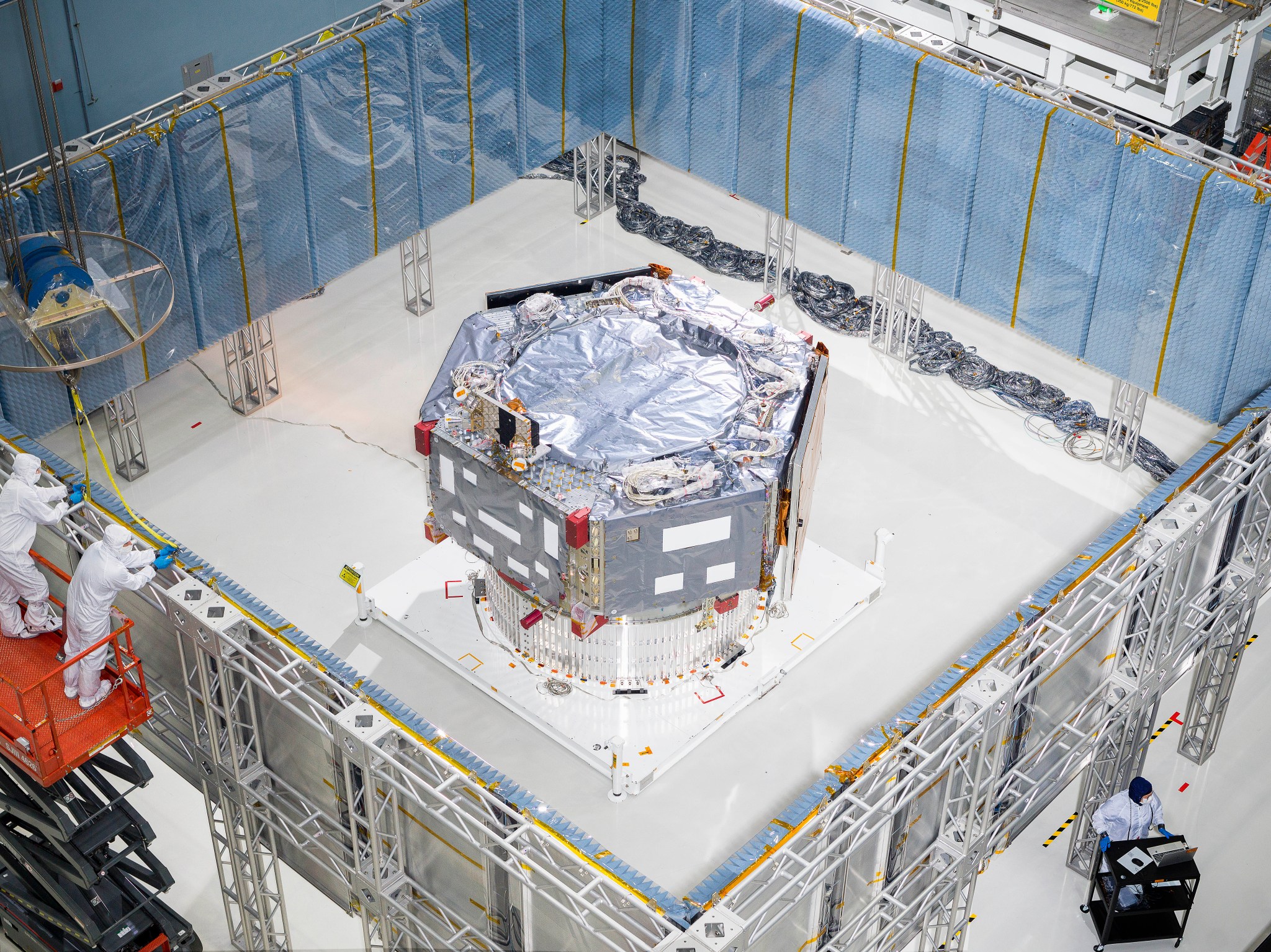 This top-down view shows NASA’s Nancy Grace Roman Space Telescope’s spacecraft bus from another angle. It rests atop an aluminum ring that will not be part of the observatory and is surrounded by an enclosure used in testing to ensure electromagnetic interference will not affect the bus’s sensitive electronics. The bus is covered in gray bagging material to prevent contamination –– even tiny stray particles could affect its performance.NASA/Chris Gunn A Goddard Grand Slam This milestone is the culmination of eight years of spacecraft design work, building, and testing by hundreds of people at Goddard.
This top-down view shows NASA’s Nancy Grace Roman Space Telescope’s spacecraft bus from another angle. It rests atop an aluminum ring that will not be part of the observatory and is surrounded by an enclosure used in testing to ensure electromagnetic interference will not affect the bus’s sensitive electronics. The bus is covered in gray bagging material to prevent contamination –– even tiny stray particles could affect its performance.NASA/Chris Gunn A Goddard Grand Slam This milestone is the culmination of eight years of spacecraft design work, building, and testing by hundreds of people at Goddard.
“Goddard employees were the brains, designers, and executors. And they worked with vendors who supplied all the right parts,” Townsend said. “We leaned on generations of expertise in the spacecraft arena to work around cost and schedule challenges that arose from supply chain issues and the pandemic.”
One time- and money-saving technique the team came up with was building a spacecraft mockup, called the structural verification unit. That allowed them to do two things at once: complete strength testing on the mockup, designed specifically for that purpose, while also assembling the actual spacecraft.
The spacecraft’s clever layout also allowed the team to adapt to changing schedules. It’s designed to be modular, “more like Trivial Pursuit pie pieces than a nesting egg, where interior components are buried inside,” Townsend said. “That’s been a game-changer because you can’t always count on things arriving in the order you planned or working perfectly right away with no tweaks.” It also increased efficiency because people could work on different portions of the bus at the same time without interfering with each other.
The slightly asymmetrical and hexagonal spacecraft bus is about 13 feet (4 meters) wide by 6.5 feet (2 meters) tall and weighs in at 8,400 pounds (3,800 kilograms).
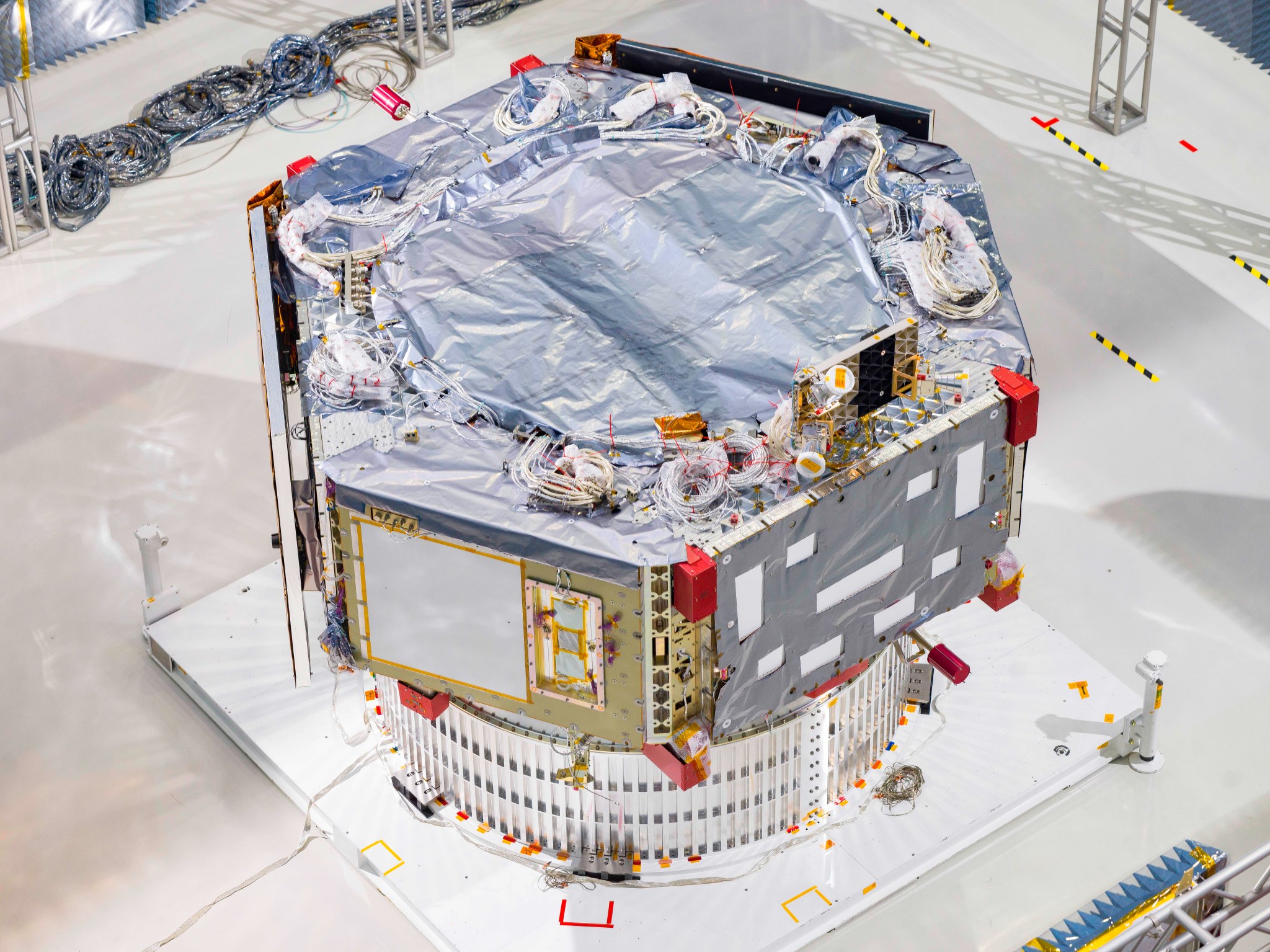 While it may look small in this photo, the spacecraft bus for NASA’s Nancy Grace Roman Space Telescope is 8 feet (2.5 meters) wide by 6.5 feet (2 meters) tall and weighs in at 8,400 pounds (3,800 kilograms). In this photo, it rests atop an aluminum ring that will not be part of the observatory. The bundles of wires on top are part of more than 50 miles of cabling laced throughout the assembly to enable different parts of the observatory to communicate with each other.NASA/Chris Gunn One reason it doesn’t weigh more is that some components have been partially hollowed out. If you could peel back some of the spacecraft’s panels, you’d find superthin metallic honeycomb sandwiched between two slim layers of metal. And many of the components, such as the antenna dish, are made of strong yet lightweight composite materials.
While it may look small in this photo, the spacecraft bus for NASA’s Nancy Grace Roman Space Telescope is 8 feet (2.5 meters) wide by 6.5 feet (2 meters) tall and weighs in at 8,400 pounds (3,800 kilograms). In this photo, it rests atop an aluminum ring that will not be part of the observatory. The bundles of wires on top are part of more than 50 miles of cabling laced throughout the assembly to enable different parts of the observatory to communicate with each other.NASA/Chris Gunn One reason it doesn’t weigh more is that some components have been partially hollowed out. If you could peel back some of the spacecraft’s panels, you’d find superthin metallic honeycomb sandwiched between two slim layers of metal. And many of the components, such as the antenna dish, are made of strong yet lightweight composite materials.
When the spacecraft bus was fully assembled, engineers conducted a comprehensive performance test. Prior to this, each component had been tested individually, but just like with a sports team, the whole unit has to perform well together.
“The spacecraft passed the test, and now we’re getting ready to install the payload –– Roman’s instruments and the telescope itself,” said Missie Vess, a spacecraft systems engineer for Roman at NASA Goddard. “Next year, we’ll test these systems together and begin integrating the final components of the observatory, including the deployable aperture cover, outer barrel assembly, and solar panels. Then we’ll finally have ourselves a complete observatory, on track for launch by May 2027.”
To virtually tour an interactive version of the telescope, visit:
https://roman.gsfc.nasa.gov/interactive
The Nancy Grace Roman Space Telescope is managed at NASA’s Goddard Space Flight Center in Greenbelt, Maryland, with participation by NASA’s Jet Propulsion Laboratory and Caltech/IPAC in Southern California, the Space Telescope Science Institute in Baltimore, and a science team comprising scientists from various research institutions. The primary industrial partners are BAE Systems, Inc in Boulder, Colorado; L3Harris Technologies in Rochester, New York; and Teledyne Scientific & Imaging in Thousand Oaks, California.
By Ashley Balzer
NASA’s Goddard Space Flight Center, Greenbelt, Md.
Media Contact:
Claire Andreoli
claire.andreoli@nasa.gov
NASA’s Goddard Space Flight Center, Greenbelt, Md.
301-286-1940

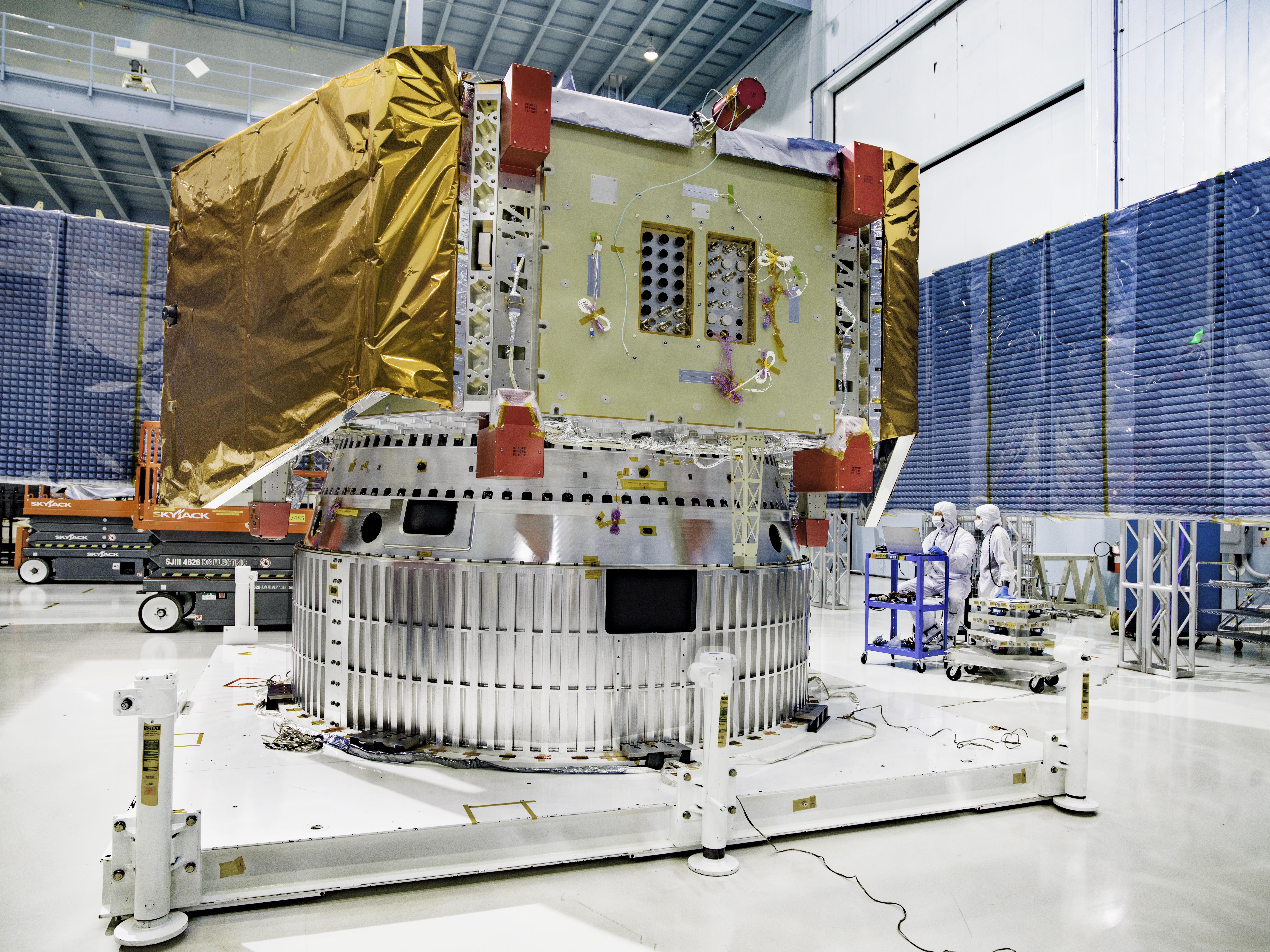
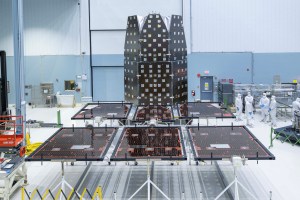 2 min read Solar Panels for NASA’s Roman Space Telescope Pass Key Tests Article 3 weeks ago
2 min read Solar Panels for NASA’s Roman Space Telescope Pass Key Tests Article 3 weeks ago  6 min read Primary Instrument for Roman Space Telescope Arrives at NASA Goddard Article 1 month ago
6 min read Primary Instrument for Roman Space Telescope Arrives at NASA Goddard Article 1 month ago  6 min read How NASA’s Roman Space Telescope Will Illuminate Cosmic Dawn Article 2 months ago
6 min read How NASA’s Roman Space Telescope Will Illuminate Cosmic Dawn Article 2 months ago 